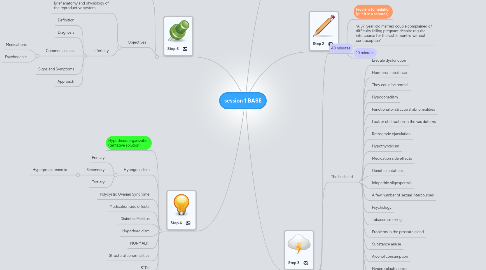
1. Step 5
1.1. 10 minutes
1.2. Objectives
1.2.1. Brief anatomy and physiology of the reproductive system
1.2.2. Infertility
1.2.2.1. Definition
1.2.2.2. Diagnosis
1.2.2.3. Common causes
1.2.2.3.1. Medications
1.2.2.3.2. Psychogenic
1.2.2.4. Signs and Symptoms
1.2.2.5. Approach
2. Step 4
2.1. Hypothesis organization (tentative solution)
2.2. Hypogonadism
2.2.1. Primary
2.2.2. Secondary
2.2.2.1. Hyperprolactenemia
2.2.3. Tertiary
2.3. Polycystic Ovarian Syndrome
2.4. Medication side effects
2.5. Diabetes Mellitus
2.6. Hypothyroidism
2.7. NORMAL!!!
2.8. Structural abnormalities
2.9. STDs
2.10. 20 minutes
3. Step 1
3.1. Identify terms and cues
3.2. New terms
3.3. cues
3.3.1. Both of them are 37
3.3.2. For the first time
3.3.3. Having diffuculty falling pregnant
3.3.4. Having regular intercourse for the last 8 months
3.3.5. without contraception
3.3.6. They're married
3.4. 10 minutes
4. Step 2
4.1. Problem formulation (put it in a senates)
4.2. "A 37-year-old married couple complained of difficulty falling pregnant despite regular intercourse for the last 8 months without contraception"
4.3. 10 minutes
5. Step 3
5.1. 40 minutes
5.2. The husband
5.2.1. Erectile dysfunction
5.2.2. Hormonal imbalance
5.2.3. They could be normal
5.2.4. Hypogonadism
5.2.5. Functional or structural abnormalities
5.2.6. Lack or obstruction in the vas deferns
5.2.7. Retrograde ejaculation
5.2.8. Hypothyroidism
5.2.9. Medication side effects
5.2.10. Genetic mutations
5.2.11. Idiopathic oligospermia
5.2.12. A few number of sexual intercourses
5.2.13. Psychology
5.2.14. Tobacco smoking
5.2.15. Problems in the prostate gland
5.2.16. Substance abuse
5.2.17. Alcohol consumption
5.2.18. Hyperprolactenemia
5.2.19. Rapid weight loss
5.2.20. Obesity
5.3. The wife
5.3.1. Polycystic Ovarian Syndrome
5.3.1.1. Obesity
5.3.1.2. Irregular menstrual period
5.3.1.3. Acne
5.3.1.4. Hirsutism
5.3.2. Obesity
5.3.3. Sexually transmitted diseases
5.3.4. Functional or structural abnormalities
5.3.4.1. Ovulation
5.3.4.2. Implantation
5.3.4.3. Fertilization
5.3.4.4. Ovulation
5.3.5. Ectopic pregnancy
5.3.6. Diabetes mellitus
5.3.7. Hypogonadism
